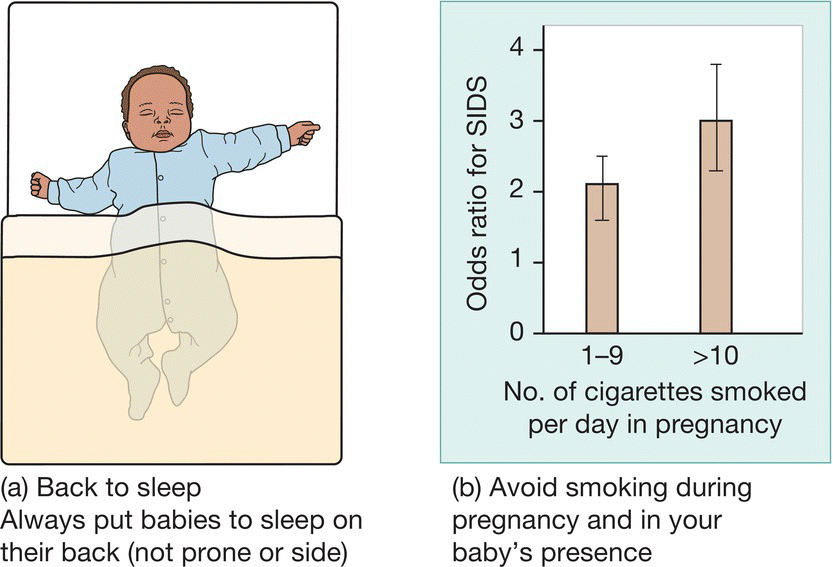16
Routine care of the newborn infant
Most term infants start to breathe several seconds after birth and become pink and active. If breathing normally, the baby can be dried and placed directly on the mother’s front. This will allow direct skin-to-skin contact, the baby being kept warm with a towel. Alternatively, the baby can first be wrapped in warm towels. It is at this time that most babies are alert and are ready to begin to establish nursing at the breast.
After birth, the midwife or pediatrician will examine the baby briefly to check there are no abnormalities. A more detailed examination, the routine examination of the newborn, will be performed later, but within 24 hours of birth (see Chapter 17). Name tags will be attached to the baby and a record made to confirm that the baby passes urine and meconium within 24 hours of birth.
Screening
The use of a screening test depends on:
- prevalence of the disease
- ease with which the test can be performed
- false-positive and-false negative screening rates
- whether it significantly improves the prognosis
- cost.
The availability of screening tests varies with judgment as to whether these criteria are satisfied.
Biochemical screening (Newborn bloodspot)
This is performed on all infants. Blood spots, usually from a heel prick, are placed on a card that is sent to a reference laboratory.
In most centers in the US, tandem mass spectrometry is used to screen a wide range of disorders (particular disorders vary by state), but all States screen for are least 29 disorders including:
- phenylketonuria
- hypothyroidism
- sickle cell disease
- thalassemia
- MCADD (medium-chain acyl-CoA dehydrogenase deficiency)
- Maple syrup urine disease (MSUD)
- Isovaleric aciduria (IVA)
- Glutaric aciduria type I (GA1)
- Homocysteinuria (HCU).
Cystic fibrosis screening is performed by measuring serum immunoreactive trypsin (IRT) and DNA analysis for mutations in CFTR (cystic fibrosis transmembrane regulator gene). The trypsin level is raised because of obstruction of the pancreatic ducts. It has a high false-positive rate, which can be reduced by combining it with DNA analysis.
In the UK, screening is confined to the disorders listed above, but an expanded program of tandem mass spectrometry is being assessed in some areas.
Audiology (see Chapter 62)
Neonatal hearing screening is universal for infants in the UK and in most States in the US.
Transcutaneous bilirubin
Used to identify infants at increased risk of developing hyperbilirubinemia and requiring more frequent monitoring (see Chapter 41).
Other possible screening tests
Pulse oximetry
Increasingly introduced in the US and UK to detect critical congenital heart disease in all infants (see Chapter 49).
Ultrasound for DDH (developmental dysplasia of the hips)
Used selectively in the UK and US, e.g. breech position, family history, but in all babies in some countries in Europe (see Chapter 17).
Routine hematocrit for polycythemia
Not recommended as not proven that treatment improves prognosis.
Health promotion
Parents should be provided with verbal and written advice about:
- feeding
- jaundice
- the importance of immunizations
- safe sleep practices to reduce the risk of SIDS (sudden infant death syndrome) (Fig. 16.1)
- the need for a car seat to take the baby home and whenever traveling in a car
- when to seek medical attention.

Fig. 16.1 Advice for parents to reduce the risk of SIDS. (a) Back to sleep. (b) Odds ratio for SIDS and number of cigarettes smoked per day in pregnancy. A more detailed list of advice for parents is listed above in the Key points.
(Adapted from Reduce the Risk of SIDS, Department of Health, UK, 2009 and American Academy of Pediatrics, 20011. Data from MacDorman M.F. et al. Sudden infant death syndrome and smoking in the United States and Sweden Am J Epidemiol 1997; 146: 249–257.)
Discharge
Before discharge, check that:
- feeding is being established successfully
- the nursing staff do not have concerns about the mother’s handling of the baby
- the baby is well and not significantly jaundiced
- timely follow-up arrangements are in place.